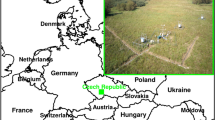Abstract
At a boulder on a hill near Casey Station, Wilkes Land, sensors for light, temperature and humidity were installed facing the four cardinal directions. The measurements lasted for about two months of the summer season 1985/86. The data recording was carried out at intervals of 6 minutes for all probes by automatic recording instruments.
Data analysis was carried out with special regard to the biological effects of the parameters analyzed. These data of the microclimatic features taken from its original place of growth were used to a regression model of potential photosynthetic activity ofUsnea sphacelata, which is a characteristic species of this area.
Although the individual time courses of the above mentioned parameters show long periods of favourable conditions for possible growth and metabolic processes, the combined analysis of these variables considering threshold values for metabolism shortens these time spans drastically. Thus, cross relationships within the physical descriptors and their effects on the actual values of photosynthesis as well as respiration become evident. They are illustrated by the results of models on photosynthesis and respiration ofU. sphacelata regarding the different cardinal directions.
Similar content being viewed by others
References
Ahmadjian, V. (1970) Adaptations of Antarctic terrestrial plants. “Antarctic ecology Vol. 2” (ed. M. W. Holdgate), 801–811, Academic Press, London.
Davis, R. C. (1983) Prediction of net primary production in two Antarctic mosses by two models of net CO2 fixation. Br. Antarct. Surv. Bull.59: 47–61.
Friedmann, E. I., McKay, C. P. &Nienow, J. A. (1987) The cryptoendolithic microbial environment in the Ross Desert of Antarctica: Satellite-transmitted continuous nanoclimate data, 1984–1986. Polar Biol.7: 273–287.
Hooker, T. N. (1980) Growth and production ofUsnea antarctica andU. fasciata on Signy Island, South Orkney Islands. Br. Antarct. Surv. Bull.50: 35–49.
Kappen, L. (1983) Ecology and physiology of the Antarctic fruticose lichenU. sulphurea (Koenig) Th. Fries. Polar Biol.1: 249–255.
— (1985) Vegetation and ecology of ice-free areas of Northern Victoria Land, Antarctica. 2. Ecological conditions in typical microhabitats of lichens at Birthday Ridge. Polar Biol.4: 227–236.
— (1986) Lichen habitats as micro-oases in the Antarctic.—The role of temperature. Polarforsch.55: 49–54.
— &Redon, J. (1984) Microclimate influencing the lichen vegetation on different aspects of a coastal rock in the maritime Antarctic. Ser. Cient. INACH31: 53–65.
—— (1987) Photosynthesis and water relations in three maritime Antarctic lichen species. Flora179: 215–229.
—,Bölter, M. &Kühn, A. (1986) Field measurements of net photosynthesis of lichens in the Antarctic. Polar Biol.5: 255–258.
——— (1987) Photosynthetic activity of lichens in natural habitats. Bibliogr. Lichenol.25: 297–312.
—,Meyer, M. &Bölter, M. (1988) Photosynthetic production ofRamalina terebrata, a maritime Antarctic lichen species. Polarforsch.58: 181–188.
Lange, O. L. (1969) Experimentell-ökologische Untersuchungen an Flechten der Negev-Wüste. I. CO2-Gaswechsel vonRamalina maciformia (Del.) Bory unter kontrollierten Bedingungen im Laboratorium. Flora158: 324–359.
— (1980) Moisture content and CO2 exchange of lichens. I. Influence of temperature on moisture-dependent net photosynthesis and dark respiration inRamalina maciformis. Oecologia45: 82–87.
— &Bertsch, A. (1965) Photosynthese der WüstenflechteRamalina maciformis nach Wasseraufnahme aus dem Luftraum. Naturwissenschaften52: 215–216.
— &Kilian, E. (1985) Reaktivierung der Photosynthese trockener Flechten durch Wasserdampfaufnahme aus dem Luftraum: Artspezifisch unterschiedliches Verhalten. Flora176: 7–23.
Legendre, L. &Legendre, P. (1983) Numerical ecology, 419 pp. Elsevier, Amsterdam.
Longton, R. E. &Holdgate, M. W. (1979) The South Sandwich Islands: IV. Botany. Br. Antarct. Surv. Sci. Rep.94: 1–53.
MacNamara, E. E. (1973) Macro- and microclimates of the Antarctic coastal oasis, Molodezhnaya. Biuletyn Peryglacjalny23: 210–236.
Odum, H. T. (1986) Energy in ecosystems. “Ecosystems theory and application” (ed. N. Polunin), 337–369. John Wiley, Chichester.
Pryor, M. E. (1962) Some environmental features of Hallett Station, Antarctica, with special reference to soil arthropods. Pacific Insects4: 681–728.
Schlittgen, R. &Streitberg, H. J. (1987) Zeitreihenanalyse, 505 pp. Oldenbourg, München.
Smith, R. I. L. (1986) Plant ecological studies in the fellfield ecosystem near Casey Station, Australian Antarctic Territory, 1985–1986. Br. Antarct. Surv. Bull.72: 81–91.
Walton, D. W. H. (1984) Instruments for measuring biological microclimate for terrestrial habitats in polar and high alpine regions: A review. Arct. Alp. Res.14: 275–286.
Author information
Authors and Affiliations
About this article
Cite this article
Bölter, M., Kappen, L. & Meyer, M. The influence of microclimatic conditions on potential photosynthesis ofUsnea sphacelata: A model. Ecol. Res. 4, 297–307 (1989). https://doi.org/10.1007/BF02348450
Accepted:
Issue Date:
DOI: https://doi.org/10.1007/BF02348450




